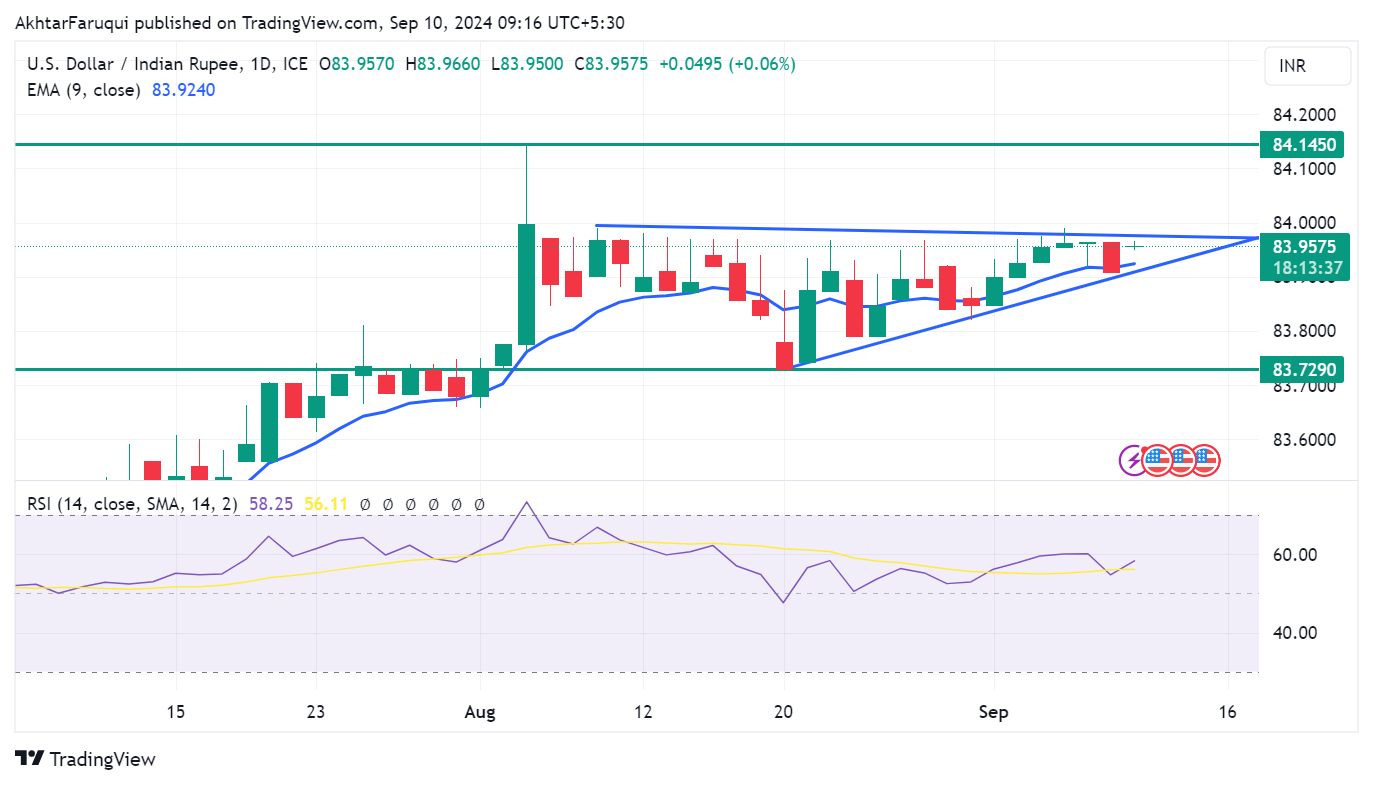- The Indian Rupee is holding its ground as traders await the RBI’s intervention to support the domestic currency.
- The USD/INR pair could appreciate if Asian markets experience a decline due to growing concerns about the US economy.
- The US dollar is supported by growing doubts about the magnitude of the Fed’s rate cut in September.
The Indian Rupee (INR) is holding steady against the US Dollar (USD) on Tuesday, with traders speculating that the Reserve Bank of India (RBI) likely intervened in the foreign exchange market to support the domestic currency and prevent it from weakening beyond the 84.00 level.
The USD/INR pair could appreciate in the near term as a broader decline in Asian equities and currencies emerges, driven by growing concerns over a possible slowdown in the US economy. However, lower oil prices may help ease the downward pressure on the INR as India, being the world’s third-largest consumer and importer of oil, would benefit from lower import costs.
The US dollar is appreciating due to the lower probability of an aggressive interest rate cut by the Federal Reserve (Fed) at its September meeting. According to the CME FedWatch tool, the probability of a 50 basis point rate cut has slightly decreased to 29.0%, from 30.0% a week ago.
Daily Market Movers Roundup: Indian Rupee holds firm on possible RBI intervention
- Chicago Fed President Austan Goolsbee commented on Friday that Fed officials are starting to align with broader market sentiment that a policy rate adjustment by the U.S. central bank is imminent, according to CNBC. FXStreet’s FedTracker, which uses a custom AI model to rate Fed officials’ speeches on a dovish-to-hawkish scale from 0 to 10, rated Goolsbee’s comments as dovish, assigning them a score of 3.2.
- India’s foreign exchange reserves hit a record high of $683.99 billion as of August 30, up from $681.69 billion previously. This increase is largely due to a substantial inflow of foreign exchange into the Indian economy, driven by robust economic growth and the much-awaited inclusion of Indian assets in JPMorgan’s main emerging market debt index, which has enhanced foreign investment.
- The ADP employment change showed on Thursday that private sector employment rose by 99,000 in August, following the increase of 111,000 in July and below the estimate of 145,000. Meanwhile, US initial jobless claims rose to 227,000 for the week ending August 30, compared with the previous reading of 232,000 and below the initial consensus of 230,000.
- “India’s Composite PMI continued to show strong growth in August, driven by an acceleration in business activity in the services sector, which saw its fastest expansion since March. This growth was largely driven by a surge in new orders, particularly domestic orders,” said Pranjul Bhandari, Chief India Economist at HSBC.
- The World Bank has raised its growth forecast for India to 7% for the current fiscal year (FY25), from an earlier projection of 6.6%.
Technical Analysis: USD/INR holds below 84.00, testing support at 9-day EMA
The Indian Rupee is trading around 84.00 on Tuesday. A check of the daily chart shows that the USD/INR pair is consolidating within a symmetrical triangle pattern, signaling a reduction in volatility and a consolidation phase. Despite this, the 14-day Relative Strength Index (RSI) remains above 50, indicating that the uptrend remains intact.
On the downside, the nine-day exponential moving average (EMA) at 83.91 serves as an immediate support, aligned with the lower boundary of the symmetrical triangle near 83.90. A break below this level could trigger a bearish reversal, putting downward pressure on the USD/INR pair and potentially pushing it towards its six-week low around 83.72.
On the resistance side, the USD/INR pair is testing the upper boundary of the symmetrical triangle near the level of 84.00. A break above this point could lead the pair towards the all-time high of 84.14, recorded on August 5.
USD/INR: Daily Chart
Indian Rupee FAQs
The Indian Rupee (INR) is one of the most sensitive currencies to external factors. The price of crude oil (the country relies heavily on imported oil), the value of the US Dollar (most trade is done in US Dollars) and the level of foreign investment are all influential factors. Direct intervention by the Reserve Bank of India (RBI) in the foreign exchange markets to keep the exchange rate stable, as well as the level of interest rates set by the RBI, are other important factors that influence the Rupee.
The Reserve Bank of India (RBI) actively intervenes in the foreign exchange markets to maintain a stable exchange rate and help facilitate trade. In addition, the RBI attempts to keep the inflation rate at its 4% target by adjusting interest rates. Higher interest rates typically strengthen the Rupee. This is due to the role of the “carry trade,” where investors borrow from countries with lower interest rates to place their money in countries offering relatively higher interest rates and profit from the difference.
Macroeconomic factors that influence the value of the Rupee include inflation, interest rates, economic growth rate (GDP), trade balance, and foreign investment inflows. A higher growth rate can lead to higher overseas investment, increasing demand for the Rupee. A less negative trade balance will eventually lead to a stronger Rupee. Higher interest rates, especially real rates (interest rates minus inflation) are also positive for the Rupee. A risk-off environment can lead to higher foreign direct and indirect investment (FDI and FII) inflows, which also benefit the Rupee.
Higher inflation, particularly if it is comparatively higher than other countries, is generally negative for the currency as it reflects a devaluation through excess supply. Inflation also increases the cost of exports, leading to more rupees being sold to buy foreign imports, which is negative for the Indian Rupee. At the same time, higher inflation usually leads the Reserve Bank of India (RBI) to raise interest rates and this can be positive for the Rupee, due to increased demand from international investors. The opposite effect applies to lower inflation.
Source: Fx Street
I am Joshua Winder, a senior-level journalist and editor at World Stock Market. I specialize in covering news related to the stock market and economic trends. With more than 8 years of experience in this field, I have become an expert in financial reporting.








